Jacqueline is a historian and art historian specialising in British Art History and History of the eighteenth and early nineteenth century. She writes books and catalogue essays, articles and reviews, for the general reader and the specialist.

REVIEWS for Jacobites: A New History of the ’45 Rebellion, Bloomsbury Publishing 2016 (paperback 2017)
Tom Holland, “A gripping, panoramic and timely account of the greatest eighteenth-century crisis to menace the Union of Great Britain.”
“A lively read, combining a good and succinct military account within wider and political social context … I enjoyed and recommend” – Book of the Month, Military History Monthly Magazine. WINNER, SILVER AWARD, BOOK OF THE YEAR 2016
Colin Kidd, The Guardian, “A fresh and historically convincing perspective … An enthralling narrative [and] and a work of penetrating insight and dispassionate balance, which is captivating from start to finish”.
Paul Monod, Court Historian, “For those who know nothing about the rebellion, Jacobites is an excellent place to begin. For those who know much about the subject, Jacqueline Riding provides a comprehensive, fair-minded and well-researched account. She will lead every reader, whatever their expertise, on an exciting and highly entertaining journey”.
Sarah Fraser, Country Life, “Witty and psychologically astute … impeccably researched yet vigorously paced … Riding has mined the archives to retrieve lost voices and her panoramic vision lets us hear the evolution of a national discourse”.
Rab Houston, BBC History Magazine “it is to Jacqueline Riding’s credit that she manages to avoid partiality. Indeed, those who want an accessible, comprehensive, even-handed, and up-to-date survey, without myth or mysticism, apology or polemic, will find her book suits their purposes admirably”, “alert to the implications of the rising for the creation of a truly united United Kingdom and for the formation of the British empire”, “the book has an unusually acute sense of person and place“, “both scholarly and readable, with 60 bite-sized chapters each presenting a detailed, vivid part of a complex rebellion”, “pieced together from many small components and first-hand perspectives … Diplomacy, warfare and politics all feature but so too does human strength and frailty; there are the great and the good (and the not-so-good) but also the more obscure, all with a fascinating part to play in one of Britain’s defining crises.”
Ian Hernon, Tribune Magazine “In this page-turning, impeccably researched account”, the author “weaves a more complex tale than is taught in schools either side of the border”.
Geoffrey Scott, The Tablet, “the most comprehensive account in modern times”, “vivid storytelling and lively characterisation“.
Stuart Kelly, The Scotsman, “a forensic and accomplished account”, “one of the most nuanced and sophisticated histories of the ’45”, “Time and again, it offers fresh perspectives and interesting angles.”
Dominic Green, Literary Review, “substantial, deeply researched and fast-moving history of ‘the Forty-Five’ … which mingles the thrill of revolt with a careful analysis of international contexts and motives.”
Catholic Herald, “Jacqueline Riding achieves a remarkable feat in producing a history which is both compulsively readable and factually packed. Having brilliantly toured the political situation of mid eighteenth-century Western Europe, she takes us along on the political (and then military) campaign trail with the Young Pretender. But the triumph of Riding’s new account of the 1745 rebellion is that, as we move from Rome, through Paris, to Scotland and England, we are taken grippingly from romance to comedy, and even high farce, before the eventual tragedy”.
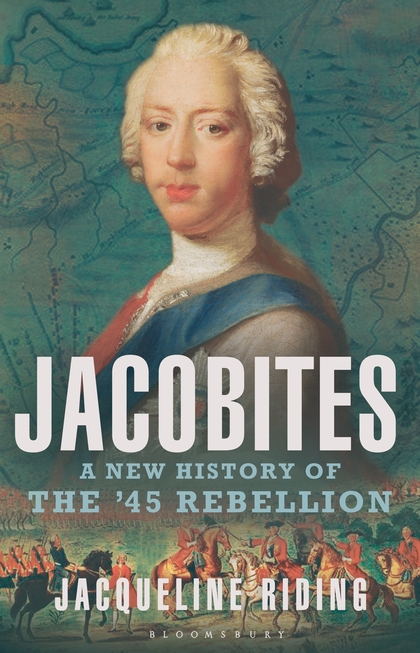
Jacobites: A New History of the ’45 Rebellion, Bloomsbury Publishing.
The extraordinary and dramatic history of Prince Charles Edward Stuart’s 1745 campaign to seize the throne of Great Britain. Tom Holland, ‘A gripping, panoramic and timely account of the greatest eighteenth-century crisis to menace the Union of Great Britain.’ Ian Hernon, Tribune Magazine ‘In this page-turning, impeccably researched account’, the author ‘weaves a more complex tale than is taught in schools either side of the border’. Geoffrey Scott, The Tablet, ‘the most comprehensive account in modern times’, ‘vivid storytelling and lively characterisation’. Buy Jacobites with 20% discount here.
Image Credit: OUT NOW - Jacobites: A New History of the '45 Rebellion (Bloomsbury Publishing)
‘Flower of Scotland: The 1745 Jacobite Rebellion’ in History Today, May 2016
Few events have been as romanticised and misunderstood as the Jacobite Rebellion. And, as Jacqueline Riding explains, politics has brought its myths to the fore once again. It was one of the images of the 2015 General Election. Not a beaming David Cameron on the steps of 10 Downing St after securing, against all the odds and the now discredited opinion polls, a Conservative majority (albeit a slim one). No, it was a photograph of Alex Salmond, former leader of the Scottish National Party (SNP) and ex-First Minister of Scotland. To read the full article click here.

British Art 1660-1735 (Yale)
Author, ‘A Session of Painters: Succession, Legacy and the Prospects for British portraiture after Sir Godfrey Kneller’ in Court, Country, City: Essays on British Art and Architecture, 1660-1735, Paul Mellon Centre/Yale University Press, June 2016.
Sir Godfrey Kneller (b.1646) died on 26 October 1723, although according to George Vertue he had been declared “past remedy (nay dead)” as early as May 1722. Alongside the regular bulletins in the London press charting Kneller’s declining health, and the tributes in prose and verse celebrating a long and distinguished career, the veteran painter’s protracted incapacity focussed attention on one issue in particular: his successor.

Canaletto – Celebrating Britain (Compton Verney)
Author, ‘From Bosworth Field to Finchley Common: Britain, Hogarth and the 1745 Jacobite Rebellion’ in Celebrating Britain: Canaletto, Hogarth and Patriotism Exhibition Catalogue, Compton Verney, Warwickshire; Holburne Museum, Bath; Abbot Hall, Kendal, March 2015.
William Hogarth, more than any other contemporary British artist, interpreted the consequences of the ’45 in a sequence of paintings and engravings that have become icons of the rebellion itself. More broadly they have also come to define (for better or worse) a very particular, one might say partial notion of Britain and “Britishness” in the post-rebellion years of the mid-eighteenth century.

Hogarth’s New Britain (History Today, December 2014)
In the winter of 1745 Prince Charles Edward Stuart’s attempt to overthrow the House of Hanover and restore the House of Stuart to the thrones of Great Britain and Ireland seemed unstoppable. On September 21st the only British troops available to crush the nascent rebellion in Scotland were routed by a predominantly Highland Jacobite army at the Battle of Prestonpans. By late November ‘Bonnie Prince Charlie’ and his troops had marched south to Manchester, while two armies commanded by Prince William Augustus, Duke of Cumberland and Field Marshal George Wade were attempting to stop their advance. On December 4th Charles and his army entered Derby, about 120 miles north of London. Two days later, on what became known as ‘Black Friday’, news reached the capital.
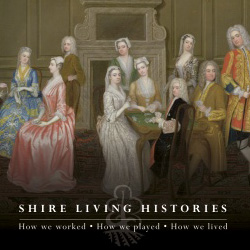
Mid-Georgian Britain
Author, Mid-Georgian Britain, Shire Living Histories, October 2010. ‘Elegant, witty and teeming with vivid details and illustrations it is the perfect introduction to life in Britain in the mid-18th Century.’ Tim Knapman, Waterstones.
‘Riding writes with a balanced, engaging style and is an accomplished historian, all apparent in the assured feel of the text.’ Lucy Inglis www.georgianlondon.com
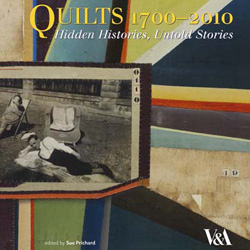
Quilts (Victoria and Albert Museum)
Author, ‘His Constant Penelope: Epic tales and domestic narratives in the George III Coverlet’ in Sue Prichard (editor), British Quilts: 1700-2010, Exhibition Catalogue, V&A 2010. Exhibition conference paper, ‘Piecing narratives, patchy history? The maker as editor in the George III coverlet.’
The ‘George III Coverlet’ with its 41 independent scenes, is an object that should be read, as much as appreciated for its complexity and technical skill. Images of warfare interlink with scenes of domestic life, as if The Illiad and The Odyssey had been updated and Britain was the new Ithaca.
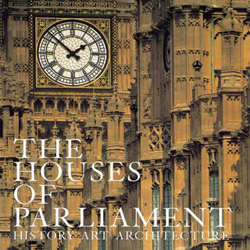
Houses of Parliament
Co-editor and contributor, Houses of Parliament: History Art Architecture, Merrell 2000. Fellow contributors include David Cannadine, William Vaughan and Gavin Stamp. ‘The text of each chapter…is scholarly without being pedantic. And the illustrations are superb.’ J. Mordaunt Crook, Times Literary Supplement

Handel House Museum
Author and editor, Handel House Museum Companion, Handel House Trust, 2001. The great composer’s life, times and home.
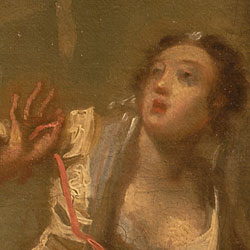
Art History
Author, ‘The mere relation of the sufferings of others’: Joseph Highmore, History Painting and the Foundling Hospital’, Art History [Journal of the Association of Art Historians], March 2012. Includes a reanalysis of the art scheme within the mid-Georgian Governors’ Court Room at the London Foundling Hospital. For the abstract see ‘News and Events’
Image Credit: Detail from Joseph Highmore, The Angel of Mercy, c.1746, Yale Center for British Art, Paul Mellon Collection.
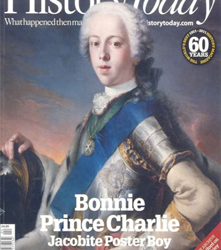
History Today (article)
Author, ‘Charlie will come again’ in History Today, April 2011. John Pettie’s ‘Bonnie Prince Charlie entering the ballroom at Holyrood’ (1892) and the making of a Jacobite icon.
The Jacobite Rebellion of 1745-46 is an important turning point in British history. Yet despite decades of re-evaluation and scholarship the event remains, among the wider public, the legend of ‘Bonnie Prince Charlie’ and his romantic but doomed attempt to regain a stolen crown.
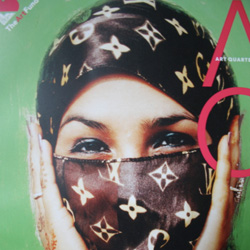
Art Quarterly
Reviewer, ‘Penelope Treadwell, Johann Zoffany: Artist and Adventurer, Paul Holberton’, 2009 in Art Quarterly (The Art Fund) Spring 2010.
Johann Zoffany (1733-1810) is invariably the bridesmaid, never the bride: often a participant but, with a few noble exceptions, rarely centre stage. He is not alone. Eighteenth-century British Art has been divided habitually between the Ages of Hogarth and Reynolds, the native-particular and the classical-grand manner, and within either camp Zoffany sits uneasily.
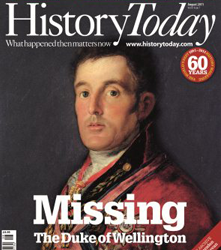
History Today (review)
Reviewer, Stella Tillyard’s The Tides of War, August 2011.
Historical fiction is no replacement for history. Nor is it history ‘lite’. It is fiction based on a recognisable past. It may be well researched, it may be based on fact and real people, but it is still fiction.